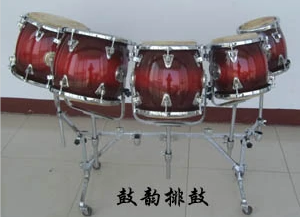The origin of the drum
673 views · Organized by 卷鹅 on 2022-03-10
Pai drum is a new variety of drum instruments. Appeared in the early 1960s, it was produced by Cai Huiquan and Yang Jingming of the China Central Broadcasting Chinese Orchestra based on the reform of medium-sized hall drums and waist drums commonly used by the people, and has been continuously improved since then.
The Jilin Provincial Song and Dance Theater Yuyanhe cooperated with the Suzhou National Musical Instrument No. 3 Factory to develop a row drum composed of thirteen drums. The drum body is made of glass fiber reinforced plastic.

The Jilin Provincial Song and Dance Theater Yuyanhe cooperated with the Suzhou National Musical Instrument No. 3 Factory to develop a row drum composed of thirteen drums. The drum body is made of glass fiber reinforced plastic.
Involving musical instruments
Pai drum is a new variety of drum instruments. Appeared in the early 1960s, it was produced by Cai Huiquan and Yang Jingming of the China Central Broadcasting Chinese Orchestra based on the reform of the medium-sized hall drum and waist drum commonly used by the people, and has been continuously improved since then. The row drum consists of a set of five drums of different sizes and sounds. The drum is 29 to 33.3 centimeters tall, 16.7 to 37 centimeters in diameter on the upper mouth, and 11.7 to 37 centimeters in diameter on the lower mouth. The outer diameter of the drum frame on both sides of each drum is the same but the inner diameter is different, which can produce two tones with different pitches, so there are ten tones in five drums. The sound of the row drums is fierce and swaying, the treble is firm and powerful, and the middle and bass are generous and bright, especially good at expressing warm and jubilant emotions.
Guess you like
Organized by 八日蝉 on 2022-02-09
In the early stage of its formation, drums were mainly used in activities related to religion, military affairs, communications, folklore, and ceremonies, for their practical functions. Later, with its rich sound and distinct rhythm, people began to regard the drum as an aesthetic object, and used it in daily entertainment or folk entertainment singing and dancing music, and the drum began to have the expressive power of musical art.
read >>
 渝公网安备 50010702504639号
渝公网安备 50010702504639号